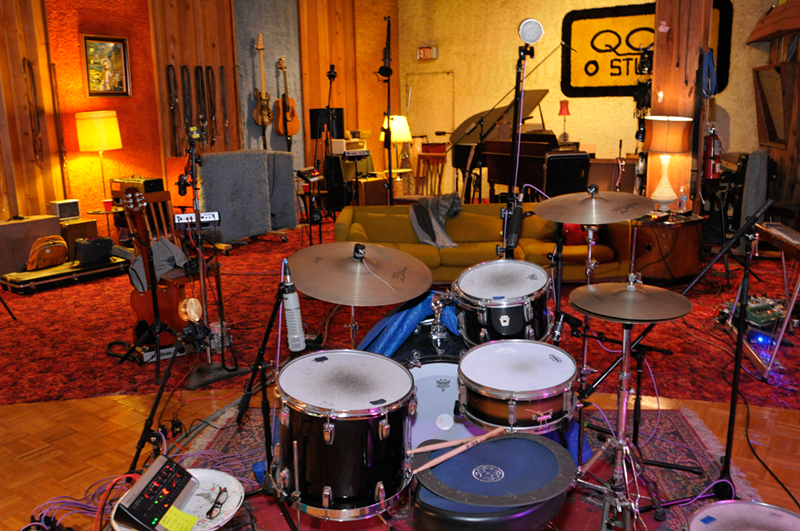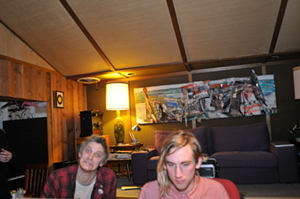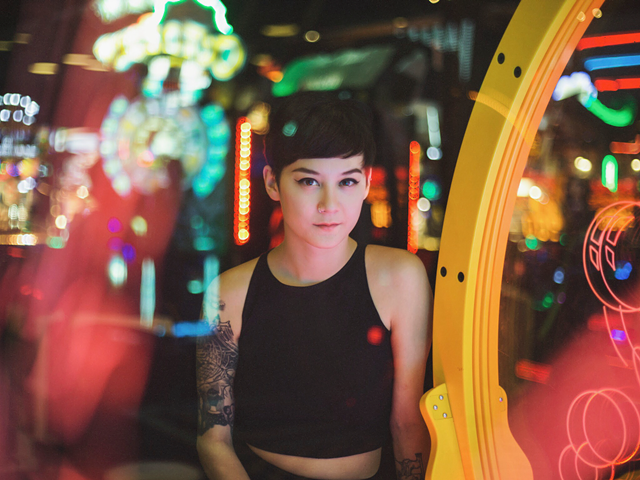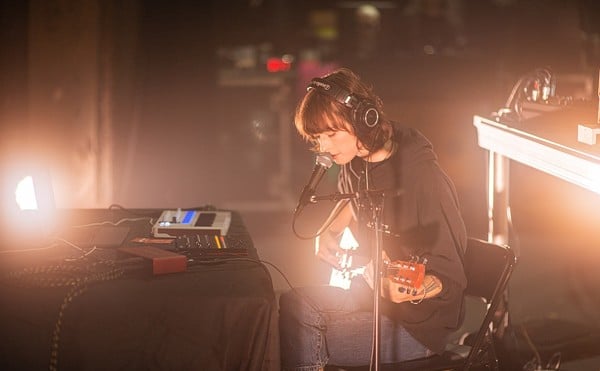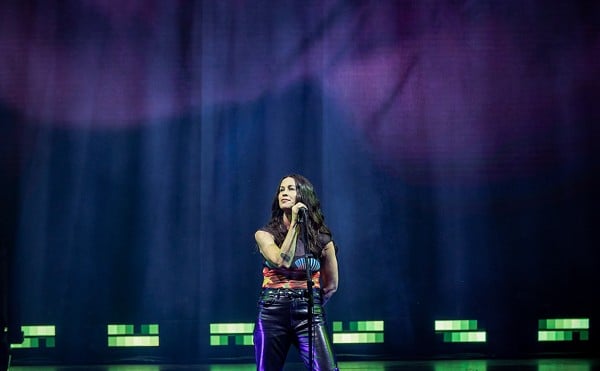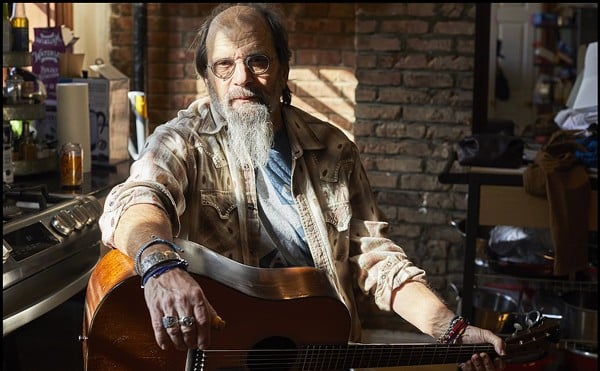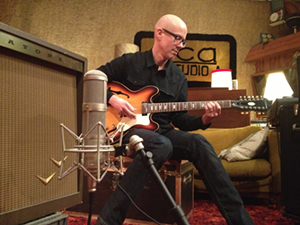
It’s a cold Thursday night in early February, and the members of my band Plastic Ants have assembled at Ultrasuede Studio to celebrate Tom Petty. Tonight we’ll be recording “Walls,” one of Petty’s mid-career shoulda-been-a-hits that was thrown away on the soundtrack he produced for Ed Burns’ 1996 commercial flop She’s The One. Following Petty’s death in late 2017, it’s a song we’ve embraced as our own after arranging and performing it for a multi-band tribute show organized by our drummer Joe Klug and hosted at the Woodward Theater.
After recording our first two albums as a quartet — with Joe on drums, me on vocals and guitar, Guy Vanasse on keys and Ultrasuede owner John Curley on bass and audio production — tonight’s session will mark the first time we’ve tracked with guitarist Robbie Reider and cellist Shira Beder.
As it happens, this is also Shira’s first-ever recording session in a professional studio. A classically trained musician, she’s performed solo and with orchestras for more than half of her young life (including a gig at Carnegie Hall; no big deal), but has only recently joined our group, a combination of play-it-by-ear rock guys and more formally trained musicians.
After catching up over our traditional meal of Dewey’s Green Lantern pizza, we crack open cans of Rhinegeist Andromeda and stage our gear in the live room while John and his intern Roberto Parker place microphones, plug in direct boxes, and set line levels in the control room. With a full band to record, this takes considerable time, but we’re in no hurry; everyone seems relaxed, including Shira, who takes in her new surroundings, noting how quiet the space is, given the deadening properties of the alternating orange and blue shag carpet that lines the walls.
Once John ensures the session is cued up for capture on the Mac system’s Logic recording software, the six of us arrange ourselves in a large circle facing inward from the live room’s perimeter and Roberto takes his place behind the glass in the control room. It’s always been a feat to align our six individual schedules, so the fact that we’re all together in one of our favorite spaces, doing one of our favorite things, is cause alone for celebration. I say something obvious to acknowledge the fact and everyone nods in recognition.
For our band and many other area musicians, this is sacred space — a place where bedroom song sketches and rehearsal-hall arrangements become shareable stabs at immortality — or at least something we can show for our time and passion. You might even be inclined to remove your shoes before entering the room, if you weren’t so aware of what’s been spilled on the studio’s mottled orange and brown carpet over the four decades it’s been hosting bands.
As shifting tastes and technological advancements have rendered traditional studios like Ultrasuede an endangered species and live ensemble recording an anomaly (sentient beings! Playing together! All at once!), our band and many others persist in the practice, not only because it’s what we know best, but also because it yields, to our ears, the most human results.
Tom Petty himself stood by that belief, and his catalog testifies to the continued relevance of the approach (Petty fans are well-acquainted with the Heartbreakers’ Herculean effort to wrestle “Refugee” onto tape while playing live in the studio all at once without error — a feat they accomplished 100 or so takes later). In a 2014 interview with CBC’s Q program, Petty engages in a prickly exchange with host Jian Ghomeshi (since outted as a super creep abuser of women), who seems to challenge Petty’s traditional recording method as an anachronism in today’s push-button pop landscape.
Petty: If you’re going to make the sort of music we make, you really need to play with musicians and actually play your instruments. We like the interplay between the musicians, so we always do our basic tracks with at least five of us playing [at the same time].
Q: It’s interesting [that you still go] for that vibe of having all the musicians in one room, playing off each other, after all these years.
Petty: Well, why wouldn’t you?
Q: Most people don’t, though.
Petty: That’s because they can’t play. People that can play do.
Q: You think so? You think it’s about people not being proficient enough?
Petty: Yes. I think it’s exactly that.
We won’t be chasing the “Refugee” unicorn of recording a complete performance without overdubs, but we will start the session by capturing the core of the track in one pass. After adjusting headphone levels, ascertaining the tempo with a click track (and ultimately deciding to record without one), we have Roberto place the computer into “record” mode and Joe counts in the song with four drumstick clicks. Three takes later, we have the basic tracks in a good place — drums, bass, piano and electric 12-string guitar — and move on to overdubbing acoustic instruments and vocals — elements that will benefit from isolated tracking without microphone bleed from louder instruments.
While the others watch from behind the glass (or grab more pizza and check their iPhones), I take a couple passes at the song in front of the Shure SM7 mic John favors for my voice. The final verse and chorus take on a special resonance given the circumstances of the recording:
“Some things are over.
Some things go on.
Part of me you carry.
Part of me is gone.
But you got a heart so big, it could crush this town.
And I can't hold out forever. Even walls fall down.”
Lead vocal complete, Guy and Joe add backing harmonies to the chorus. Shira tracks her cello. I add my acoustic guitar. Joe dubs tambourine and shaker. And Robbie strums what he calls “diamonds” on his Rickenbacker 625 12-string (the model pictured on Petty’s Damn The Torpedoes), chords that outline the song’s basic structure and add dynamics. About five hours after entering the space, we’ve finished tracking the song and John sits at the recording desk adjusting individual track levels, EQ and effects on a rough mix.
By the time we pack up for the night, noting that the morning’s demands will arrive too soon, we’re feeling somewhat fatigued but mostly elated in the knowledge that we’ve captured a little magic at Ultrasuede, paying what feels like the right kind of tribute to Petty’s ongoing inspiration. What we don’t know, however, is that it’s also the last song we will ever record at this location.
Watch the music video for Plastic Ants' cover of "Walls" below:
Plastic Ants. Walls. A Celebration of Tom Petty. from Requisite Recordings on Vimeo.
Two weeks after our tracking session, John texts the group to say the building’s new owner has decided to end the studio’s lease. Ultrasuede must vacate the premises by April 1, mere weeks away, and inconveniently timed with John’s departure for a tour with his long-running band, The Afghan Whigs. We’d known it was a possibility earlier in the year, but John believed he’d reached an agreement that would allow him to stay, albeit under tight new restrictions about hours of operation. Joe, who has recorded and rehearsed countless times at the studio, sums up the situation’s magnitude with his usual economy, typing, “Jesus. End of an era.”
The single-story brick building at 2834 Spring Grove Avenue was the former location of Queen City Audio, a ’70s-era one-stop recording facility where bands could record, mix, master and press vinyl, all under one roof. Even though the QCA logo was still emblazoned in black on one cream-colored wall, John had resided in the space since 1993, operating as Ultrasuede, a name he’d maintained since the mid-’80s, when he first started recording bands in various locales throughout the city.
At the Spring Grove address, John produced and/or engineered essential recordings by numerous acts, including Joe’s band Wussy, The Greenhornes, White Stripes, Ronnie Spector, Patti Smith, Ass Ponys, Buffalo Killers, Magnolia Mountain, Pearlene, Heartless Bastards and Barrence Whitfield & The Savages. His early production successes include the Whigs’ covers EP Uptown Avondale and album tracks such as Congregation’s “Miles Iz Ded” and Gentlemen’s “If I Were Going.” He even recorded the violin-like whine that opens the Whigs’ Black Love album by ambient mic’ing the railroad tracks that wind past the studio and recording the sound of a freight train’s squealing brakes, which were later cross-faded in the mix with a Hammond B-3 organ.
In more recent years, John has worked with a talented young engineer/producer named John Hoffman who also plays in the bands Swim Team and Vacation. Among many other projects with local and out-of-town bands, Hoffman co-produced Wussy’s most recent album, What Heaven Is Life, picking up where Curley left off with the band’s previous work and bringing his own aesthetic sensibilities to the party.
On a cold, gray Saturday afternoon in early March, John and I drive to the studio to pack up some gear to take to his newly rented storage space. Sipping his usual high-octane cold brew from Coffee Emporium (“It takes a lot to turn this engine over,” he quips), he navigates the slushy back streets of Camp Washington and addresses the tangle of emotions he’s feeling about vacating the studio after so many years. Characteristically, he’s not focused on how the situation will affect him; it’s ultimately bigger than that.
“I felt like I was acting as a steward of that space until the next person came along,” he says. “And I thought John (Hoffman) would be that person. But now that won’t happen.”
On a separate visit a few weeks later, I enter the building on Spring Grove to help move the last of the studio’s gear with John, John Hoffman and Guy, my writing partner in the band. Things look much different without John’s stuff — the recording equipment, the paintings by local artists, the assorted curios collected, gifted or abandoned at the studio over the years, including a molded fiberglass hand-shaped chair that hung horizontally from the live-room wall, serving as a cable rack. Emptied of its contents, the facility starts to reveal its age. It becomes obvious that the space itself is not the spirit of Ultrasuede. The energy has moved on. A closure of sorts now seems possible, like the effect of seeing a body lying in state at a wake.
We all snap a few last photos of the live room on our iPhones while John ponders whether to save the hand chair, which sports a prodigious crack in its palm-shaped seat. Guy takes a photo of it in the empty space, types “waving bye bye” under the file and texts it to his son Julian, who was also a frequent creator in the studio and now studies Music Technology in New York, a college major inspired in part by his work with John in this very room. The chair has accumulated sentimental value over the years, appearing as it has in countless photos of the studio, even if it’s now functionally useless. Or perhaps not completely useless. To lighten the mood, I suggest we hack off three of its fingers and leave it as a parting gesture for the landlord.
Two months later, John returns from his tour with the Whigs and brings with him good news: Ultrasuede will resume business at The Lodge, a recording studio and multi-media makerspace located in a rehabbed Masonic hall in Dayton, Kentucky. It’s an architecturally significant space owned by John’s friend and fellow photographer Scott Beseler, and run with Paul Brumm, who built the studio and serves as its chief engineer, and John Wirick, who also engineers at the studio and runs The Lodge-affiliated label, Masonic Sounds.
Curley teases the new arrangement on Ultrasuede’s Instagram page with a cryptic photo of his hand holding a set of keys and a plastic cigarette lighter emblazoned with The Lodge’s dotted-triangle logo. “Fresh reel” reads the caption below it.
“That looks promising,” I text him regarding the post. He types back, “Yeah, for sure. It’s a cool spot. Lots going on there, too. Early indications suggest I landed well.”
It’s a landing that will ultimately serve the community well — music makers and music lovers alike. Some things are over. Some things go on. Ultrasuede is dead. Long live Ultrasuede.
Stream or download Plastic Ants’ “Walls” single at plasticants.bandcamp.com.

